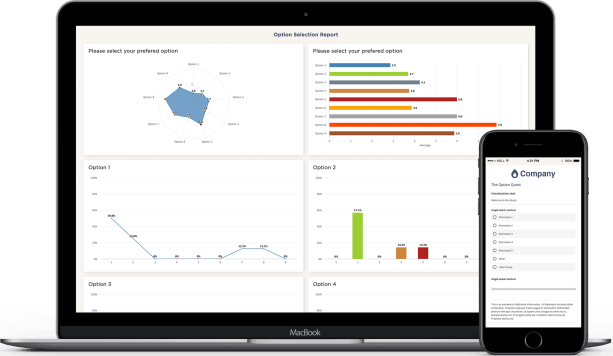101 Great Questions to Ask During an Employee Survey


Table of Contents
Try Questback 14 days for free.
Introduction
Ever wonder what your employees really think about working at your company? Great businesses do – and they ask. Employee surveys give every team member a voice, and the results can fuel improvements in engagement, culture, and even the bottom line. Research shows that companies with highly engaged employees enjoy 21% higher productivity and are 22% more profitable than those with low engagement. In other words, if you want a thriving business, start by listening to your people through well-designed employee surveys. And with the right platform (like Questback), gathering honest employee feedback becomes easier than ever.
Employee feedback can be collected in various ways – from quick daily check-ins (like the one pictured above asking “How was your day?”) to in-depth annual engagement surveys. Regardless of the method, the goal is the same: to understand how employees feel and what they need to succeed. When employees know their opinions matter, they become more driven, engaged, and loyal, which positively impacts productivity and even customer satisfaction. A thoughtful survey program, supported by Questback’s tools, is an ideal way to regularly tap into these insights and drive continuous improvement.
How to Conduct an Effective Employee Survey
Conducting an effective employee surveys involves more than just sending out a list of questions. It requires careful planning, smart question design, and creating an environment of trust so employees feel safe to respond candidly. Here are some best practices to ensure your survey yields meaningful feedback:
- Define Clear Objectives: Be specific about what you want to learn (e.g. improve team communication, gauge morale post-reorg). Clear goals will guide your questions and make the survey results more actionable.
- Craft Clear, Neutral Questions: Use simple language and ask one thing at a time. Avoid leading or loaded wording that nudges respondents toward a certain answer. For example, instead of “Don’t you agree our leadership is great?”, ask “How would you rate the effectiveness of our leadership?”
- Mix Question Types: Include a balance of rating-scale questions (to quantify trends) and open-ended questions (to capture detail and suggestions). This gives you both measurable data and rich context.
Equally important is protecting anonymity and fostering psychological safety. Employees are far more likely to speak their minds if they know their responses can’t be traced back to them personally. In fact, one study found using anonymous surveys can increase participation rates by 23% [1] – not surprising when up to 71% of employees [2] admit they hold back honest feedback if they fear confidentiality issues. Make it crystal clear that responses will be confidential. Psychological safety – employees’ confidence that they won’t face negative consequences for candid feedback – is crucial. If workers worry their frank opinions will be held against them, they may sugarcoat answers or skip the survey altogether. Emphasize that the survey’s purpose is to improve the workplace, not to single anyone out, and that honest feedback (even the critical kind) is valued.
Fortunately, modern tools like Questback make it easy to implement these best practices. Questback provides quality-tested survey templates and built-in anonymity features to encourage honest, transparent feedback. You can assure your staff that responses are truly confidential – Questback’s platform doesn’t store identifying info when anonymity is enabled, so managers see aggregate data, not individual names. The platform also streamlines data collection by allowing multi-channel participation (web, mobile, etc.) and sending automated reminders to boost response rates. With a user-friendly dashboard and easy sharing of reports, Questback takes the legwork out of analyzing results. In short, it gives HR professionals and executives a turnkey way to gather employee insights while adhering to survey best practices.

Use Employee surveys to figure out what drivers you should focus on!
In this whitepaper, you will find 33 concrete tips that you can act on to immediately increase employee engagement at your workplace.
101 Great Employee Survey Questions (Categorized)
Now that your survey process is set up for success, the next step is asking the right questions. Below are 101 example employee survey questions, grouped into key categories, to help you cover all the bases. These questions touch on everything from daily motivation to long-term career growth. Use them as inspiration – you can tailor the wording to fit your organization and choose appropriate response formats (Likert scale, multiple-choice, or open-ended) for each. Aim for a mix of question types to get both quantitative ratings and qualitative feedback.
Engagement & Motivation
These questions gauge how committed, enthusiastic, and motivated employees feel in their day-to-day work. They help reveal whether people find purpose in their roles and are willing to go the extra mile.
- Are you motivated to give your best effort at work each day?
- Do you find your work meaningful?
- Do you understand how your work contributes to the organization’s goals and success?
- Do you feel proud to work for this company?
- Do you feel recognized and appreciated for your contributions by your manager or team?
- How excited are you to come to work each morning?
- Does your team or colleagues inspire you to do your best?
- Do you feel a sense of personal accomplishment in your job?
- Are you enthusiastic about your daily tasks and responsibilities?
- Are you willing to go the extra mile to help the company succeed?
- Open-ended: What motivates you to excel in your role?
- Does your job make good use of your skills and talents?
- Do you enjoy your day-to-day work overall?

Workplace Culture & Values
These questions explore the company’s culture and whether it aligns with employees’ values. They address communication, teamwork, respect, and how well the organization lives up to its stated values.
- How would you describe our workplace culture in a few words?
- Do you feel a sense of belonging at this company?
- Does our culture encourage open and honest communication?
- Do colleagues treat each other with respect in this organization?
- Do you believe the company values are practiced in our daily work?
- Is there a culture of teamwork and collaboration here?
- Does the organization show that it cares about employees’ well-being?
- Are employees at all levels held accountable for living our values?
- Does our culture support innovation and trying new ideas?
- Do you feel the company fosters an environment of trust and transparency?
- Are successes and good work celebrated in our company?
- Do you feel comfortable voicing feedback or ideas in our workplace culture?
- Open-ended: What would you change about our workplace culture if you could?
Try Questback 14 days for free.
Leadership & Management
These questions focus on leadership effectiveness and management practices. They help assess if managers are communicating, supporting, and guiding their teams well, and if senior leadership is trusted and inspiring.
- Does management clearly communicate the company’s goals and strategies to you?
- Do you feel that senior leadership listens to employee feedback and concerns?
- Do your managers and supervisors treat employees with respect and fairness?
- Do you receive regular feedback on your performance from your manager?
- How effective is your immediate manager at supporting and guiding you in your work?
- Do you trust the senior leadership team of this company?
- Are you satisfied with the leadership provided by top management?
- Does your manager support your professional development and career growth?
- Do you feel valued by the leadership of the organization?
- Are decisions by management transparent and well-explained?
- Do you feel comfortable approaching your manager with questions or concerns?
- Does leadership recognize and acknowledge employee achievements?
- Open-ended: What is one thing you would like our leadership team to improve on?

Use Employee surveys to figure out what drivers you should focus on!
In this whitepaper, you will find 33 concrete tips that you can act on to immediately increase employee engagement at your workplace.
Work-Life Balance
Work-life balance questions uncover whether employees feel they can maintain healthy boundaries between work and personal life. They identify issues like burnout, workload, and flexibility.
- Are your work hours reasonable for maintaining a healthy work-life balance?
- Do you feel you have enough time to recharge outside of work?
- How often do you feel stressed or burned out by your work?
- Does the company support flexible work arrangements (e.g. flex hours, remote work) when needed?
- Do you feel pressure to work during your personal time (evenings, weekends)?
- Can you take the vacation or personal time off you need without guilt?
- Does management respect your time outside of work (for example, avoiding unnecessary after-hours emails)?
- Do you feel you can balance your work and personal life effectively?
- Does your job allow you to attend to family or personal responsibilities when they arise?
- How satisfied are you with your current work-life balance?
- Open-ended: What could we do to help you achieve a better work-life balance?
- Does our company culture promote a healthy balance between work and life?
Career Growth & Development
These questions assess whether employees feel they have opportunities to learn, grow, and advance in their careers within the company. They highlight areas like training, mentorship, and fair promotions.
- Do you have clear opportunities for career growth at this company?
- Does the company provide the training and development you need to do your job well?
- Do you feel you can reach your professional goals here?
- Has your manager discussed your career path or advancement opportunities with you in the past six months?
- Do you have access to the resources and tools to develop new skills?
- Are you satisfied with the mentorship or coaching available to you?
- Do you feel encouraged to pursue learning and development opportunities?
- In the last year, have you had opportunities to learn new skills or grow in your role?
- Are promotions and advancement decisions made fairly at our company?
- Do you feel you are growing and improving in your current role?
- Do you understand the requirements to advance your career here?
- Open-ended: What training or development opportunity would you most like to have that you don’t currently?
Discover what truly motivates your employees so you can skyrocket your productivity and profitability.
Remote Work & Hybrid Models
For organizations with remote or hybrid work arrangements, these questions gather feedback on those policies. They uncover if employees have what they need to be productive remotely and feel included.
- Are you satisfied with our company’s remote work policy (or hybrid work arrangement)?
- Do you have the tools and technology you need to work effectively from home?
- Do you feel as productive working remotely as you do in the office?
- Does the company effectively communicate with fully remote or hybrid employees?
- Do you feel included in team activities and decisions when working remotely?
- How often would you ideally work from home vs. the office? (Multiple-choice: e.g. Full-time remote, a few days a week, etc.)
- Does your manager support your flexible scheduling or remote work needs?
- Do you feel the company trusts employees to work remotely without micromanaging?
- Does the organization provide enough support for remote workers (such as stipends for home office equipment or internet)?
- How satisfied are you with the mix of in-office vs. remote work in your current schedule?
- Do you have the right level of work-life separation when working remotely (i.e., can you “turn off” work at the end of the day)?
- Open-ended: What is the biggest challenge you face when working remotely, and how could we help?
Diversity, Equity, and Inclusion
These questions gauge the inclusiveness of the workplace. They ask if employees of all backgrounds feel respected, and if the company is fair and proactive about DEI (Diversity, Equity, and Inclusion).
- Do you feel that all employees are treated fairly, regardless of gender, race, age, or background?
- Does our company actively promote diversity and inclusion in the workplace?
- Do you feel you can be yourself at work (i.e. that you’re accepted and included regardless of your identity)?
- Have you witnessed or experienced any bias, discrimination, or harassment at work in the past year?
- Do you believe our workplace is inclusive of diverse perspectives and ideas?
- How well does the company handle reports of discrimination or harassment? (e.g. promptly and effectively?)
- Do you feel that your ideas and opinions are valued, regardless of your position or background?
- Does the organization provide equal opportunities for advancement and promotion to all employees?
- Do you see diversity in our leadership and teams (in terms of different backgrounds, genders, etc.)?
- Do you feel comfortable reporting an incident of bias or unfairness to HR or management?
- Does your team respect and value individual differences and perspectives?
- Open-ended: What is one thing we could do to improve diversity, equity, or inclusion at our company?
- Do you believe the company’s actions and policies reflect a true commitment to inclusion?
Try Questback 14 days for free.
Job Satisfaction & Retention
These questions assess overall job satisfaction and identify retention risks. They ask how employees feel about their role, if they’re considering leaving, and what might make them stay.
- Overall, how satisfied are you with your job at this company?
- Do you feel valued and appreciated as an employee of the company?
- Are you satisfied with your compensation and benefits for the work you do?
- Does your job meet the expectations you had when you started?
- Would you recommend this company as a great place to work to friends or family?
- Do you see yourself working here in a year (or two years)?
- Have you recently considered looking for a job elsewhere?
- Do you feel a sense of job security in your role?
- Do you feel this company is a place where you can build your career long-term?
- Do you feel a sense of loyalty to the company?
- What do you enjoy most about working here? (Open-ended)
- What is one thing that would increase your satisfaction and likelihood to stay with the company? (Open-ended)
- Do you believe the company genuinely cares about employee satisfaction and well-being?

How to Analyze and Act on Employee Feedback
Collecting survey responses is only half the journey – the real impact comes from analyzing the feedback and taking action. Once your employee survey closes, start by examining the data for patterns and insights. Break down results by department, tenure, location, or other relevant segments to spot trends. For example, you might find that one team reports lower morale, or that employees with 5+ years at the company are less satisfied with career growth. Questback simplifies this step with its analytics dashboard, which can automatically segment data and highlight key trends, making it easy for HR and leaders to interpret the results. With easy sharing of reports built in, you can quickly disseminate findings to managers and executives and collaborate on next steps.
After analysis, the most important step is acting on the feedback. Employees will only continue to provide input if they see that it leads to real change. In fact, ignoring survey results can be very costly – 41% [3] of employees have left a job because they felt their feedback was not listened to. To avoid this, be sure to close the feedback loop: share a high-level summary of the survey findings with your workforce, and outline the actions the organization plans to take. Thank employees for their honesty and time. Even if some feedback points can’t be addressed immediately, acknowledge them. When employees see that their feedback leads to tangible changes, it builds trust in management [4] and boosts morale. One study found that when employee suggestions do result in important changes, those employees are about 18 times more likely [5] to recommend their company as a great place to work – a massive increase in loyalty and engagement.
Begin with a few quick wins to demonstrate responsiveness. For example, if many people requested better communication about company goals, you might start a monthly email from the CEO to address that need. Communicate these improvements: “You said X in the survey, so we are doing Y.” According to Questback’s experience, some employees skip surveys because they don’t believe any change will come of it – proving them wrong is key. Be transparent about what will happen post-survey. Let everyone know what changes are being made based on the results, and even what cannot be changed (with reasons why). This level of follow-through shows respect for employees’ input. It signals that the survey wasn’t just a checkbox exercise; leadership is actually listening and taking feedback seriously. You can even involve employees in brainstorming solutions for issues raised – that collaboration can further increase buy-in.
Throughout this process, Questback can be an invaluable partner. The platform not only helps collect feedback but also makes it easier to act on it. You can set up automated alerts for critical feedback, generate action-plan templates, and track progress on initiatives over time. By integrating survey results into your HR strategy (for instance, linking engagement scores with retention rates or performance metrics), you turn feedback data into a powerful driver of organizational improvement. The end goal is to create a positive feedback loop: employees give input, the company responds and improves, which in turn encourages even more honest feedback in the future.
Conclusion
In summary, a well-designed employee survey is a powerful tool for improving your workplace. By asking great questions and truly listening to the answers, HR professionals and executives can uncover what drives engagement, where the pain points are, and how to boost overall job satisfaction. Acting on employee feedback leads to higher morale, lower turnover, and better performance – the very outcomes that drive business success. It’s no coincidence that companies known as “great places to work” are often also top performers in their industries. They understand that engaged, heard employees are productive employees.
The key is to treat surveys not as a one-time task, but as part of a continuous improvement cycle. When you show employees that their opinions matter and follow through on making changes, you create a culture of trust and openness. Questback makes this journey easier at every step – from crafting the survey to analyzing results and closing the loop. If you’re ready to elevate your organization’s engagement and performance, consider using Questback for your next employee survey. It’s the ideal platform to help you improve workplace satisfaction and performance by turning honest employee insights into actionable results. Encourage your team to speak up, listen to what they say, and watch your workplace thrive. Your employees have great ideas and valuable feedback – with Questback, you’ll ask the right questions and ensure those insights lead to a better company for everyone.
External Sources
1: Increase Participation – https://psico-smart.com/en/blogs/blog-what-are-the-psychological-effects-of-anonymity-in-employee-survey-too-189233#:~:text=perceived%20confidentiality%20of%20survey%20responses,Practically%2C%20organizations%20should
2: Hold backs honest feedback– https://psico-smart.com/en/blogs/blog-what-are-the-psychological-effects-of-anonymity-in-employee-survey-too-189233#:~:text=In%20the%20quest%20for%20genuine,psychological%20benefits%20of%20anonymity%E2%80%94where%20takingGet honest feedback –
3: Leaves job if not listened to – https://explodingtopics.com/blog/employee-feedback-stats#:~:text=%2A%2041,engaged%20after%20receiving%20negative%20feedback
4: Build trust in management – https://www.springworks.in/blog/why-you-need-to-close-the-feedback-loop/#:~:text=,Engagement%20leads%20to%20higher%20productivity
5: More likely to recommend company https://www.leadershipiq.com/blogs/leadershipiq/study-the-risks-of-ignoring-employee-feedback#:~:text=%2A%20Only%206,company%20as%20a%20great%20employer

Try Questback
Questback is a leading Customer and Employee Experience solution that makes it easy to collect, analyse and take action on key stakeholder insights.









